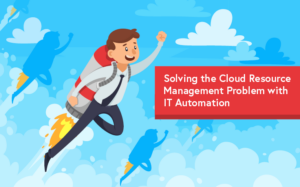TechEd 2013: Workload Automation Extends Cloud Computing
Workload Automation is essential to virtual and cloud computing because Workload Automation provides dynamic provisioning and intelligent management.

Workload Automation Helps Manage Cloud Resources
Most IT experts and professionals would agree that virtual and cloud computing has the potential to bring efficiency and value to enterprise computing in ways never seen before. Cloud computing is evolving at an unprecedented pace, with many organizations jumping directly, in varying degrees, to private or public cloud use.
In the thick of all this activity is a stalwart of the industry: workload automation. Workload automation brings the organization and management of an enterprise’s common workloads and processes into a single framework to optimize their execution and completion. The opportunity is now presenting itself to extend these benefits to the management of virtual and cloud-based resources.
Bringing the provisioning/management of cloud resources into the automation equation is the most effective way to automatically allocate resources to workload processing where and when it’s needed. Rather than provisioning server resources for peak demand – and paying the price for under-utilization during low workload demands – the era of cloud computing provides the ability to match workload execution with resource capacity in a pay-as-you-go model. A single IT automation is required to ensure that capacity matches closely with workload demand, thus eliminating the costs of idle resources between spikes in workloads.
TechEd 2013
This is exactly why at TechEd 2013 we announced that we’re extending ActiveBatch’s cloud management capabilities to include the Microsoft Azure platform, becoming the first enterprise job scheduling and workload automation vendor to integrate with Microsoft Azure. The idea is to allow IT organizations to dynamically manage and automate Azure resources to match workload processing demands, allowing your workload automation solution to automatically provision additional Azure instances prior to a spike in workloads and then de-provision them after the workloads are completed to return their resources for use elsewhere, reducing IT operational costs in the process. This same solution serves as a central point of control for automating those workflows that span physical, virtual and Azure environments.
While Azure has been a hot topic among this year’s attendees, the automation of bread and butter processes and technologies: SQL Server, System Center and IT operational processes, PowerShell scripts, automating cross-platform workflows that include Windows, Linux and UNIX, still reigns supreme.
Conversations About Workload Automation:
- The Architectural solution to an elemental problem has a clear benefit for Attendees. As discussed in an earlier blog entry here, Users are looking to unify “point” scheduling tools which include Task Scheduler, SQL Server Scheduler, PowerShell, Cron and more via an advanced architectural strategy allowing users to cross the boundaries and limitations within their current IT Process Automation environments.
- Attendees are interested in ways in which System Center Orchestrator can be brought into the ActiveBatch framework. The available ActiveBatch Extension for Orchestrator allows users to schedule and run Orchestrator Runbooks from within ActiveBatch as part of a larger ‘architectural framework. There is also the capability for ActiveBatch jobs to be directly accessed and triggered from within Orchestrator. This simplifies the management, monitoring and integration of IT Operational and Business Processes.
- Attendees are also interested in leveraging the available Integrated Jobs Library via ActiveBatch Extensions for Microsoft System Center Operations Manager, Service Manager, Virtual Machine Manager, SharePoint, Exchange and Active Directory with new integrations supporting Orchestrator, Dynamics AX, Team Foundation Server and Azure to eliminate silos of automation and better coordinate IT and Business processes from a single point of control.
Struggling to Manage Your Cloud Resource?
Find out how automation can maximize your virtual and cloud resource:








